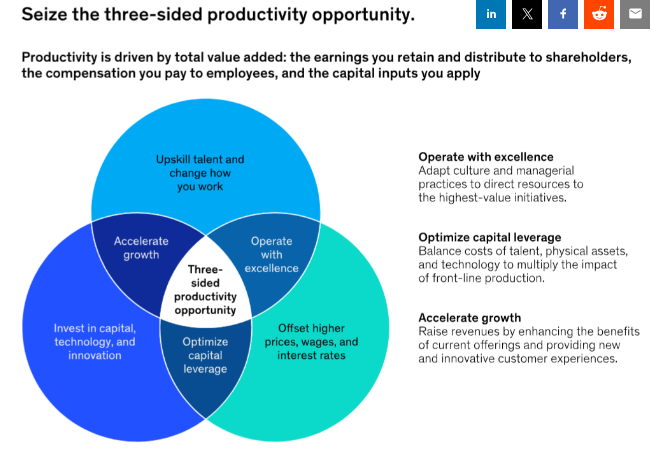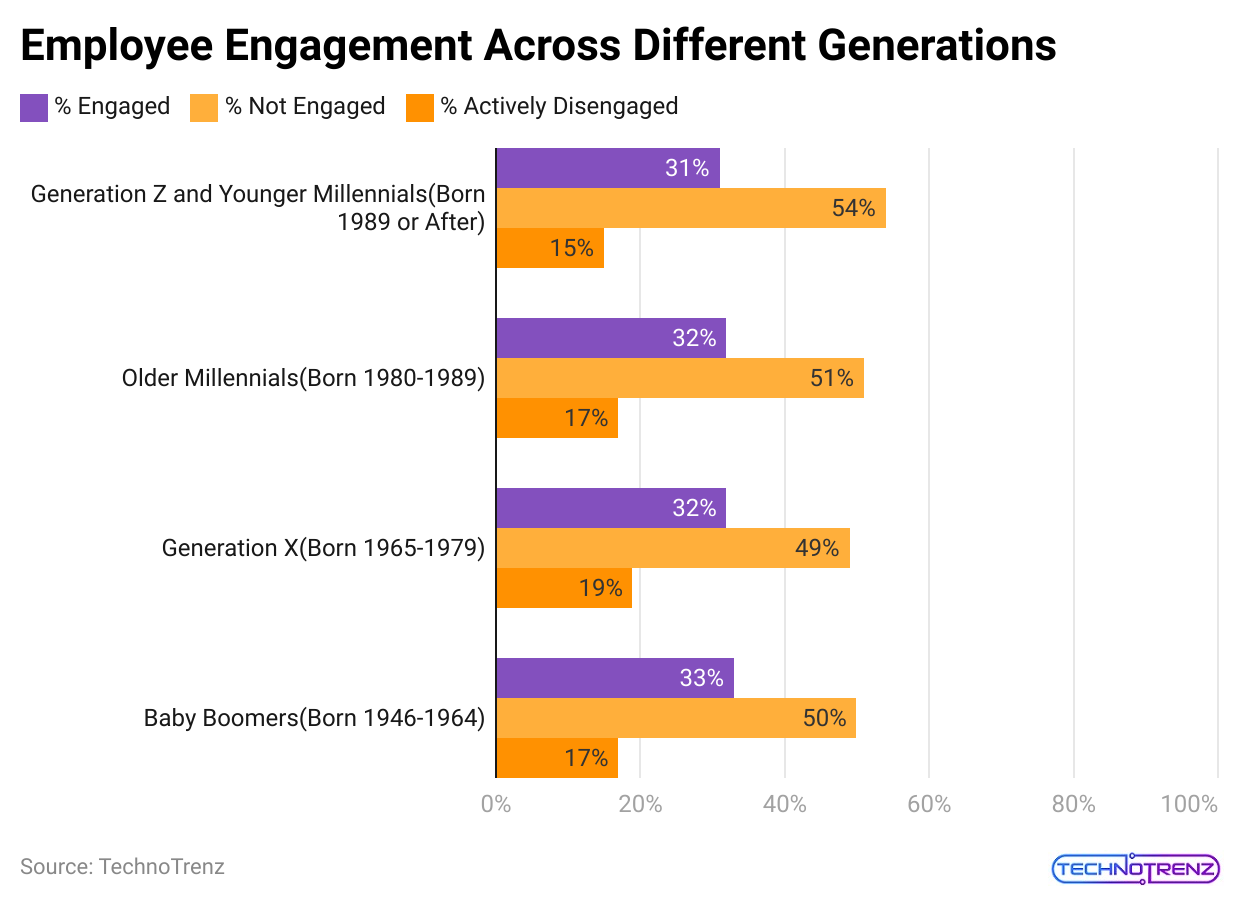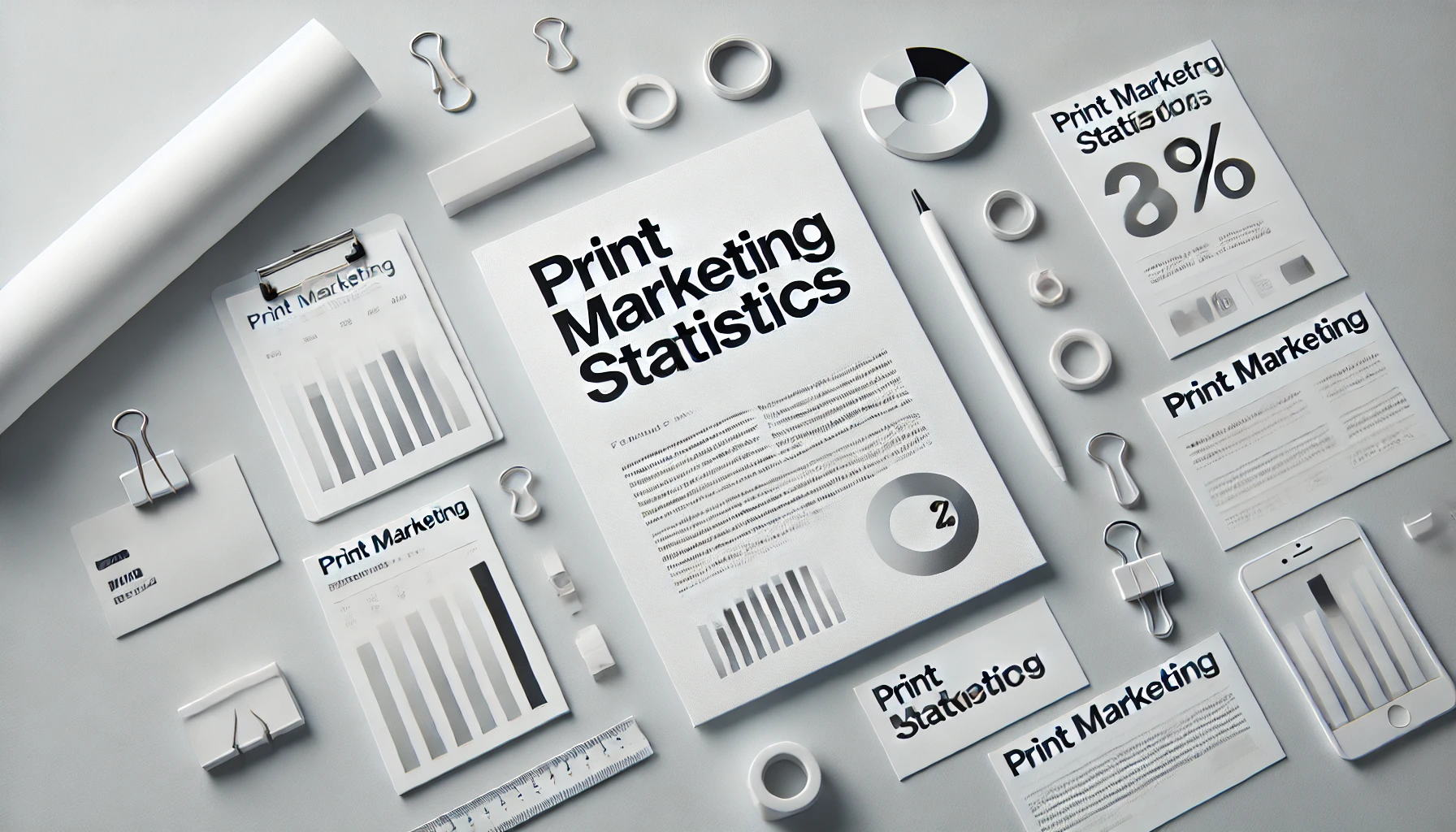Productivity In The Workplace Statistics By Employer Productivity, Employee Reports, Challenges, Impact, Technology And Productivity
Updated · Aug 30, 2024

WHAT WE HAVE ON THIS PAGE
- Introduction
- Editor’s Choice
- Factors Affecting Productivity In The Modern Workplace
- General Productivity In The Workplace Statistics
- Productivity And The Modern Workforce Statistics
- Working Remotely Can Transform Efficiency
- Employee Productivity Over Time Statistics
- Are Healthy Employees More Productive?
- Employer Productivity In The Workplace Statistics
- Workplace Distractions By Employee Reports
- Employee Engagement And Satisfaction
- Productivity Challenges Statistics
- Productivity Impact Of Multitasking
- Major Factors Influencing Productivity In 2024
- Technology And Productivity At Workplace Statistics
- Workplace Collaboration Statistics
- Conclusion
Introduction
Productivity In the Workplace Statistics: Employee productivity is very important for any business and affects how well it performs. With a standard 40-hour work week, employees contribute about 2,000 hours of work each year. How these hours are used can vary a lot. Measuring Productivity can be challenging, as it can depend on different factors like the job role, the company, and the industry.
We can examine Productivity from different perspectives to get a clearer picture. This report,” Productivity In the Workplace Statistics”, will show you how Productivity appears from both the employee’s and the employer’s viewpoints. You’ll also learn how engagement, job satisfaction, and technology impact Productivity in the workplace.
Editor’s Choice
- Freelance workers are productive for up to 88% of their workday.
- Productivity In the Workplace Statistics stated that almost 23% of workers who are engaged actively at work are highly productive.
- As of 2023, a single distraction can waste nearly 5.8% of the workday.
- Actively engaged employees experience 44% less workplace stress.
- 70% of employees believe fewer meetings lead to better Productivity.
- In the U.S., 91% of employees say they feel more engaged at work.
- About 41% of employees say stress reduces their Productivity.
- 80% of workers feel stressed due to poor organizational communication.
- Workers spend up to 32% of their time on Facebook, which costs companies about $28 billion annually.
- Tuesday is the most productive day of the week, with an average work time of 6 hours and 44 minutes.
- The highest focus times are on Monday (4 hours and 42 minutes) and Friday (4 hours and 24 minutes).
- Only 7% of workers feel productive at their workplace.
- Productive businesses have about 48% higher operating margins than less productive ones.
- Productivity In the Workplace Statistics state that around 24 billion hours are wasted each year due to unproductive meetings.
- On average, employees are 13% more productive when working remotely, and overall Productivity in the U.S. has increased by 5% since the pandemic began.
- After a distraction, it takes about 23 minutes and 15 seconds to regain focus.
- The average worker is productive for 2 hours and 53 minutes per day, which is only 31% of an 8-hour workday.
- Digital workers are productive for an average of 6 hours and 59 minutes each day.
- More productive workers use AI and automation, 242% and 78% more often, respectively.
Factors Affecting Productivity In The Modern Workplace
With technology and the Internet, we can work from almost anywhere, but this also means we bring along habits that waste time. Here are some common reasons why our Productivity might suffer:
- Social Media at Work
Many people check their phones and social media during work hours. Statistics show that we spend about 1.5 hours a day scrolling through social media, adding up to 7.5 hours a week. This makes social media one of the top time-wasters at work.
- The Internet
While the Internet has transformed how businesses operate, it can also be a major distraction. Despite strict company rules, many employees spend around 21 hours a week online, which is about 48% of the workday. This includes surfing the web, checking social media, or online shopping.
- Personal vs. Work Communication
Communication is key in any job, but personal calls, texts, and messages take up about 56 minutes a day. This is a common part of modern work life, but cutting down on unnecessary personal conversations can help save time. The same goes for limiting small talk with colleagues to keep work time focused.
- Email Overload
Email is a crucial part of workplace communication, but checking it can be a big time-waster. In 2023, employees checked their emails about 121 times a day, which takes up 28% of the workweek. Improving email efficiency and streamlining communication can help reduce this wasted time.
- Poor Training Practices
Training new employees is important, but many companies need to do it better. New hires often need clarification about applying what they’ve learned. Around 25% of workers think their training could be more useful, costing companies millions of dollars each year.
- Lack of Motivation and Distractions
A lack of motivation and frequent distractions are major time-wasters. On average, employees get distracted every 11 minutes, and it can take up to 25 minutes to refocus. This significantly affects Productivity.
- Low-Value Tasks
Despite having specialized skills, many employees spend time on simple tasks like filling out timesheets or generating reports. These basic tasks, which could be automated, waste an entire workday each week, adding up to about 50 days a year.
General Productivity In The Workplace Statistics
- Productivity in the Workplace Statistics stated that 48% of employees say they are productive less than 75% of the time.
- Additionally, 18% report being productive less than half of the time.
- A 2023 McKinsey survey of 15,000 people found that over 50% feel they are “relatively unproductive” at work, though details weren’t provided.
- 82% of employees believe that happiness and engagement are crucial for Productivity.
- The focus on wellbeing will increase in 2024. Being connected to company culture, having a sense of purpose, and having good relationships with managers are key to boosting Productivity.
- Low engagement is costing the global economy $8.8 trillion in lost Productivity.
- According to Gallup’s 2023 report, disengaged and burned-out employees are wasting 9% of the world’s GDP.
- Engagement levels are slowly improving, but 77% of workers still need to be actively engaged.
- Engaged employees are 18% more productive and 23% more profitable, according to Productivity In the Workplace Statistics.
- In contrast, disengaged employees cost their companies 18% of their salary in lost Productivity.
- Improving employee engagement is a major factor in boosting workplace productivity in 2024.
- According to Productivity in the Workplace Statistics, employees spend 60% of their time on “work about work.”
- This includes 103 hours a year in unnecessary meetings, 209 hours on duplicated tasks, and 352 hours discussing work. Much of this time could be more productive and could be demotivating.
- 87% of their Desk workers using AI are 90% more likely to report higher Productivity.
- AI will be a major investment for companies in 2024. According to PwC, 86% of COOs are investing in new technologies, and 44% of CEOs believe generative AI (like ChatGPT) will boost profits this year.
 (Reference: bluewren.co.uk)
(Reference: bluewren.co.uk)
- 42% of COOs see labor shortages as a big challenge for Productivity in 2024. To attract top talent, PwC suggests investing in automation tools and collaboration software to provide flexible work options that job seekers want.
- 53% of employees feel pressured to respond to messages quickly, even outside of work hours.
- As stress levels rise, work-life balance will become a more important factor in employee engagement and Productivity.
- 87% of employees say they would be more productive if they could choose how many days they work from home.
- The top reason for working from home is to boost Productivity, followed by avoiding the commute.
- Flexibility in work arrangements helps employees choose the best environment for their Productivity.
- Employers offering “radical flexibility” see a 40% higher percentage of high-performing employees.
- “Radical” flexibility means giving employees control over their schedules. By using integrated systems for scheduling and project management, companies can enhance performance and reduce burnout.
Productivity And The Modern Workforce Statistics
- According to Slack, the most productive employees are 242% more likely to use AI than the less productive employees.
- 77% of employees believe that automating routine tasks would boost their Productivity. Thanks to automation, employees save an average of 3.6 hours per week.
- McKinsey reports that generative Artificial Intelligence can develop the productivity of the labour by 0.1% to 0.6% yearly through 2040, depending on how widely the technology is adopted and how workers are redeployed to other tasks.
- When combined with other technologies, work automation could add between 0.5% and 3.4% to annual productivity growth, according to Productivity In the Workplace Statistics.
- Despite these benefits, AI tools have not yet been widely adopted. Only 23% of leaders surveyed by Slack have upgraded their technology in the past six months to boost Productivity. Nearly two-thirds of companies still need to start using AI.

(Source: selectsoftwarereviews.com)
- Productivity expectations have shifted recently due to factors like the COVID-19 pandemic, the rise of hybrid work, and fast changes in AI technology.

(Source: selectsoftwarereviews.com)
- According to McKinsey, to Boost Productivity in the future, companies should focus on a few key areas:
- Upskill employees and restructure operations to improve efficiency.
- Handle higher costs and interest rates wisely and invest in capital and technology carefully.
- These strategies can help companies operate more efficiently, support workers, sustainably raise wages, and speed up growth.
Working Remotely Can Transform Efficiency
- Productivity In the Workplace Statistics stated that almost 77% of employees say they are more productive when working from home.
- While offices have their perks, working remotely can boost Productivity and cut down on stress from long commutes and prep times. Plus, remote monitoring tools can help keep track of team performance, no matter where they are.

(Reference: zippia.com)
- In the above chart, we can see the remote work using educational level statistics.
- Productivity In the Workplace Statistics stated that around 64% of global business leaders believe flexible work options improve Productivity.
- As flexible work arrangements become more common, it’s important to measure how Productivity compares between in-office and remote work to make informed decisions. Companies might find that flexibility actually enhances Productivity.

(Reference: zippia.com)
- In the above statistics, we can see that remote work by age.
|
Age |
% |
| 18-34 years |
20% |
|
35-54 years |
29% |
| 55+ |
27% |
- 86% of employees report they are most productive when working alone from home.
- Although working from home can limit social interaction, allowing employees to work alone can increase their productivity and sense of control.
- 86% of employees prefer working alone. While this isn’t always possible, finding a balance between solo work and team collaboration can boost overall Productivity.
- More than two-thirds of employers have seen higher Productivity from remote workers.
- According to Productivity In the Workplace Statistics, companies like Best Buy and British Telecom reported productivity increases of 35-40% after switching to remote work.
- AT&T found that remote workers put in five more hours per week than their office-based peers.

(Reference: zippia.com)
- In the above chart, we can see the remote work by using gender statistics.
- 83% of workers think they can be productive without working in an office. If your company isn’t ready to go fully remote, making the office more inviting can help motivate employees to come in.
- One-third of remote workers would be happier if their efficiency were closely monitored.
- While employee monitoring software is common, some workers may resist it. To maintain trust, it’s important to explain why monitoring is used, such as to track projects and prevent time theft.
- 82% of remote employees’ managers worry about reduced Productivity.
- It can be difficult to gauge employees’ work without seeing them in person. Regular meetings and performance reviews can help managers keep track of remote workers’ progress.
- Productivity In the Workplace Statistics stated that employees are 24% happier if they can work from home once a month.
- Offering some remote work can boost employee happiness and Productivity. Remote monitoring software can monitor and track Productivity.
- Employees who work from home are 52% less likely to take time off. Allowing occasional remote work can lead to fewer sick days, more hours worked, and higher engagement.
- Freelancers typically work about 36 hours a week. While the standard 40-hour work week often doesn’t reflect actual working hours, freelancers often put in extra time managing their work and themselves.
Employee Productivity Over Time Statistics
Productivity has improved over time, but technology has also brought many distractions. Despite this, workers in the United States are now more productive than ever. Here are some key points to consider:
- Microsoft 365, which includes tools like PowerPoint, Outlook, Excel, and Word, is the most commonly used productivity software. Because it’s cloud-based, it’s easy to track, store, and manage data.
- The market for productivity management software is expected to grow at a rate of 14.2% per year from 2021 to 2028.
- Currently valued at $42.62 billion, it is projected to reach $119.69 billion by 2028.
- From 1979 to 2020, Productivity increased by 161.8%. However, wages only grew by about 17.5% during the same period.
- Technology is responsible for much of the productivity boost, although it has also led to more distractions for workers.

(Source: enterpriseappstoday.com)
- As of January 2023, the average workweek for employees in the United States was 34.6 hours in private non-farm sectors. Here’s how the average weekly hours changed over the months:
- February: 34.5 hours
- March: 34.4 hours
- April: 34.4 hours
- May: 34.3 hours
- June: 34.4 hours
- July: 34.3 hours
- August: 34.4 hours
Are Healthy Employees More Productive?
- Sick employees often perform poorly and can spread illnesses, like the flu, to their colleagues. This can lead to even more absences and lower overall Productivity. Good employee health is essential for high Productivity.
- More than 75% of productivity losses are due to health issues, costing companies two to three times more than annual healthcare expenses.
- Employees with poor diets are 66% more likely to experience a drop in Productivity. Those who struggle to exercise during the day are 96% more likely to see increased productivity losses.
- According to Productivity In the Workplace Statistics, workers aged 30 to 40 are most likely to suffer from productivity losses.
- Poor employee well-being results in $322 billion in lost turnover and Productivity worldwide each year.

(Source: selectsoftwarereviews.com)
- Employees who aren’t doing well at their jobs are 61% more likely to experience burnout, 48% more likely to feel daily stress, and 66% more likely to worry daily.
- Only about 25% of American workers feel their company cares about their health and wellbeing.
- 1% of companies say obesity affects Productivity and job performance, while 43.5% see it as a mobility challenge in the workplace.
- Productivity in the Workplace Statistics show that absenteeism costs employers $82.3 billion each year, and presenteeism adds another $160.3 billion.
- By 2030, extreme heat is expected to cause over $4 trillion in lost productivity annually.
- High temperatures decrease work accuracy and affect Productivity more in older and less skilled workers. In jobs requiring manual labor, Productivity can drop by up to 4% per degree Celsius (7.2°F) above 27°C (80°F).
- A 1-degree increase in the average temperature over ten days can raise the chance of worker absence by up to 5%.
- Productivity in the Workplace Statistics stated that a wet bulb temperature above 28°C (82°F) can reduce Productivity by 5.8%.
- 52% of employees have at least one chronic condition, and 53% say it affects their Productivity and focus at work. Among Gen Z and Millennials, this number rises to 76%.
- 94% of leaders agree that workers with chronic conditions are less productive, with 60% saying these workers lose at least 6 hours of Productivity each week.
Employer Productivity In The Workplace Statistics
- On average, 31 hours per month are lost in unproductive meetings. About 37% of workers think these ineffective meetings are a major cost for their company.
- Each year, this amounts to 24 billion lost work hours.
- Nearly 71% of employees waste time every week due to meeting cancellations and unnecessary meetings.
- Highly productive companies have operating margins that are 30% to 50% higher than those of less productive companies.
- Research shows that the most productive businesses are up to 40% more efficient than their competitors. This shows that Productivity is more important than overall efficiency.
- In 2023, the average corporate worker spends about 4 to 5 hours per week preparing for and attending meetings.
- Around 54% of workers say their meetings last more than 30 minutes.
- Additionally, 35% of workers believe they waste 2 to 5 hours each week on meetings without any real benefits.
- 76% of workers think that using wearable technology provided by their company could help improve Productivity. However, many employees are concerned about how their health and fitness data would be used by their employers.
- Workers spend nearly 2.35 hours per day on social media, which is up to 32% of their workday.
- Facebook is a major culprit, according to Productivity In the Workplace Statistics, costing businesses around $28 billion in lost productivity each year.
- About 80% of workers feel stressed because of poor communication within their organization. This issue has increased by about 30% from 2018 to 2019. Poor communication can cost companies an average of $26,000 annually.
- Multitasking can decrease Productivity by up to 40%.
- In reality, 98% of people struggle with multitasking or cannot do it effectively, so it’s no surprise that trying to multitask lowers Productivity.
- Social media is a major distraction, with about 37% of workers checking it during work hours.
- Other common distractions include talking about non-work topics with coworkers (38%), reading news sites (45%), taking smoking breaks (28%), and making hot beverages (31%).

(Reference: enterpriseappstoday.com)
- After a distraction, it usually takes about 23 minutes and 15 seconds to refocus on a task. Since the average worker gets interrupted every 3 minutes and 5 seconds, it’s no wonder productivity is so low.
- Less than 25% of workers like working in groups. This preference can affect Productivity, especially since workers have reported a 50% increase in time spent on phone calls, meetings, and emails over the past five years. These activities now take up nearly 80% of their time.
- About 70% of workers admit they are distracted at work. Around 16% say they are often distracted, and 54% feel they need to perform at their best.
Workplace Distractions By Employee Reports
- Productivity In the Workplace Statistics stated that around 16% of employees say they waste about 2 hours a day at work.
- 20% of employees admit they waste time because they are bored or uninterested in their work.
- 31% of workers waste at least 31 minutes every workday and 1 hour each day.
- Less than 60% of work time is productive, and 6% of employees waste around 3 hours a day at work.
- Additionally, 2% of employees waste 4 hours daily, and another 2% waste more than 5 hours on a typical workday.
- 53% of employees say they take short breaks for non-work activities to help boost their Productivity.
- Workers generally think that most interruptions they face at work are minor, as per Productivity In the Workplace Statistics.
- 4% of workers report they waste at least 4 hours each day at work.
| Distracting Activity | % of Employees Who Participate |
| Household activities |
14% |
|
Reading/drawing |
16% |
| Coffee breaks |
19% |
|
Other coworkers’/office noise |
25% |
| Snack breaks |
25% |
|
Socializing with coworkers |
27% |
| Bathroom breaks |
39% |
|
Texting |
44% |
| Social media |
45% |
|
Surf the Internet |
47% |
- The average worker checks their email 36 times every hour.
- Not only do emails take up a lot of time, but it also takes about 16 minutes for someone to get back on track after reading or responding to an email. This reduces the time available to do real work.
- Moreover, constantly handling emails can lower a worker’s Productivity, even if they’re focused on other things.

(Reference: jobera.com)
- Studies show that dealing with a continuous flow of emails can lower a worker’s IQ by about 10 points, similar to losing a full night of sleep.
- The average worker receives about 304 work emails each week. Many of these are unnecessary, spammy, or poorly written, wasting time and money as employees sort through them and try to understand their content.
- Spam emails cost companies roughly $1,250 per employee in lost Productivity as per Productivity In the Workplace Statistics.
- Unnecessary emails can cost around $1,800 per worker, while poorly written emails can cost between $2,100 and $4,100 per employee.
- Employees are interrupted by emails 121 times a day. The lost time is from more than just the interruptions; on average, workers spend two hours each day trying to refocus after being disrupted.
- Checking social media and browsing the Internet are two of the biggest distractions for employees. These are among the top 10 distractions during work hours, with a high percentage of workers admitting they get sidetracked by them.
| Distracting Activity | % of Staff Members who participate |
| Drawing/reading |
16% |
|
Household activities |
14% |
| Other colleagues/office noise |
25% |
|
Socializing with colleagues |
27% |
| Coffee breaks |
19% |
|
Snack breaks |
25% |
| Texting |
44% |
|
Surf the Internet |
47% |
| Bathroom breaks |
39% |
|
Social media |
45% |
Employee Engagement And Satisfaction
- Employees who feel their opinions are valued at work are 4.6 times more likely to feel motivated to do their best.
- 85% of employees need to be more engaged or are actively disengaged at work.
- 70% of employees believe that managers saying “thank you” more often would boost their motivation and morale.
- As per Productivity In the Workplace Statistics, only 13% of employees worldwide are engaged in their jobs.

(Reference: pumble.com)
- Employees who feel their opinions aren’t considered are three times less likely to be engaged.
- Productivity In the Workplace Statistics stated that almost 20% of high-potential employees feel bored and disengaged at work.
- 64% of employees would be more likely to stay with their company if they felt appreciated.
- 35% of employees say that having a clear sense of purpose makes them more productive at work, while 67% feel lonely at work.
- 71% of employees are happy with their jobs when they have a good work-life balance.
- 39% of employees feel unappreciated at work, which affects their motivation and productivity.62% of employees work remotely at least sometimes.
- Over 70% of employees say that opportunities for career growth are important for their job satisfaction and Productivity.
- 33% of employees think that poor leadership is the biggest barrier to Productivity.
- 56% of employees feel that performance reviews don’t help them improve their Productivity.
- According to Productivity In the Workplace Statistics, 49% of employees feel disengaged because they don’t feel recognized for their work.
- 30% of employees say that doing repetitive tasks lowers their motivation and Productivity.

(Source: gomada.co)
- 59% of employees think that better communication could boost Productivity.
- 77% of employees believe that flexible work hours would increase their Productivity.
- Productivity In the Workplace Statistics stated that almost 38% of employees think that a lack of transparency from leadership hurts Productivity.
- 69% of employees are more likely to stay with a company for three years if they had a great onboarding experience.
- Remote workers say they are happier, less stressed, and more productive than those who work in an office.
- 60% of employees feel disengaged because they need more recognition from their managers.
Productivity Challenges Statistics
- The modern workplace is frequently troubled by problems like poor collaboration, inefficient email use, and time wasted on social media and other distractions.
- Employees face hidden productivity issues due to emails, smartphones, the Internet, and social media.
- During the pandemic, 53.7% of remote workers said smartphones were a major distraction, while 30.4% were distracted by gaming, both of which reduced Productivity.
- Additionally, 55.8% of those working from home found the lack of social interaction to be the most annoying part of the remote work setup.
- 21% of remote workers spend about one hour of their workday on their phones, and 10.7% spend three or more hours. Surprisingly, employees only spend 60% or less of their workday on productive tasks.
- On average, employees waste 28% of their workday on unnecessary distractions and spend 27% of office hours feeling disorganized.
- The COVID-19 pandemic made these issues worse, as companies had to set up remote work quickly. Overcoming these technology-related challenges has been a significant struggle for many.
- Since the COVID-19 pandemic, workers have reported mental health issues affecting their Productivity, such as trouble concentrating (28.3%), taking longer to complete tasks (20%), difficulty with thinking or decision-making (14.7%), procrastinating on difficult work (12.4%), and juggling tasks (11.8%).
- 61% of employees find loud coworkers to be a major distraction. According to HubSpot, the top productivity killers are mobile phone use/texting (50%), gossip (42%), internet browsing (39%), social media (38%), and snack breaks (27%). Other distractions include noisy colleagues (24%), meetings (23%), emails (23%), and coworkers dropping by (23%).
- Globally, 4% of organizations need help to create a productivity-focused mindset among employees.
- Other challenges include quality of work (33.1%), staying focused (27.7%), team communication (24.6%), lack of visibility (21.5%), work-life balance (19.2%), organizational culture (18.5%), and maintaining relationships (17.7%).
- 65% of employees use the Internet for non-work-related activities during work hours, as per Productivity In the Workplace Statistics.
- Despite smartphones and fast Internet, employee productivity has only grown by about 1%.
- On average, employees spend 13 hours per week checking email.
- Employees spend roughly 20 hours online each week, with 5 hours spent on non-work-related sites.
- The average knowledge worker spends 11.7 hours each week processing emails.
Productivity Impact Of Multitasking
- Multitasking can reduce Productivity by up to 40%, and workplace distractions can also lead to a 40% drop in Productivity.
- Meetings can use up to 50% of an employee’s workday.
- Remote workers take longer breaks but are often more productive.
- Flexible work options can boost Productivity by 17%, while unclear roles and responsibilities can cut employee productivity by 50%.
- In a typical 8-hour workday, employees are productive for only 2 hours and 53 minutes.
- Employees who take regular breaks are 13% more efficient than those who don’t.
- Productivity In the Workplace Statistics stated that over 50% of employees waste at least one hour a day on distractions.
- Caffeine can improve work performance by 11% on average.
- A lack of team collaboration can increase project failure rates by 50%.
- Employees who exercise during work hours are 23% more productive on those days. For every minute spent planning, an hour is gained in execution.
- Productivity In the Workplace Statistics stated that employee burnout costs around $125 to $190 billion annually in healthcare expenses.
- Flexible work arrangements can improve Productivity by 16%. Email overload can decrease Productivity by 40%.

(Source: hbr.org)
- Well-organized meetings can increase productivity by 34%, according to Productivity In the Workplace Statistics.
- Remote workers are 35-40% more productive than those working in the office. Workplace noise can reduce Productivity by 66%.
- An 8-hour workday usually results in only 2 hours and 53 minutes of actual productive work.
- Workers spend an average of 2.6 hours per week searching for documents they can’t find.
- Personal technology devices at work can reduce Productivity by 40%, and digital distractions can also reduce Productivity by up to 40%.
- Active communication within teams can boost Productivity by 25%.
- Inefficient processes account for a 20-30% loss in Productivity, and workplace distractions cause a 40% drop.
- On average, employees spend 31 hours in unproductive meetings each month.
- Each unnecessary email costs a company $1.00 in lost Productivity.
- Remote workers are about 4% more productive than those in the office. Multitasking can reduce Productivity by up to 40%.
Major Factors Influencing Productivity In 2024
Several factors affect how productive the workforce is, both positively and negatively. Here are some key ones:
Employee Engagement
- According to Gallup, disengaged employees can cost a company around 18% of its salary budget in lost Productivity.
- In 2024, improving employee engagement is expected to have the biggest impact on workplace productivity.
- While it’s challenging, consistent effort can lead to significant improvements.
Automating Tasks
- Think about the time saved when customer orders are updated automatically, eliminating the need for manual data entry and daily updates through meetings.
- In 2023, about 77% of employees reported saving up to 3.6 hours a week thanks to such automation.
- Though it might require an initial investment, it can be very beneficial in the long run.
Using AI
- Artificial Intelligence (AI) is a major investment for improving Productivity in 2024.
- In 2023, 27% of desk workers said they were using AI, and 90% of them reported higher productivity levels as a result.
Labor Shortage
- Finding, training, and keeping skilled workers is a major ongoing issue for companies.
- According to PwC, 42% of Chief Operating Officers (COOs) see labor shortages as a big productivity challenge for 2024.
- To address this, companies need to invest in automation tools and collaboration software so employees can work more effectively from anywhere.
Technology And Productivity At Workplace Statistics
- During the lockdown, over 75% of employees used video conferencing while working from home. Of these, 75% reported that their Productivity increased because of it.
- Using digital time-management tools can make employees 47% more efficient, but 82% of people don’t use these tools at all.
- 46% of workers say they are more productive because they use email, the Internet, and cell phones.
- Instant messaging systems have also helped improve Productivity:
- Slack claims its app boosts Productivity by 32%.80% of Microsoft Teams users believe the app makes them more productive.
- Using technology for team collaboration can increase team efficiency by 131%.
- Gamification apps make 89% of employees feel more productive, and another 89% say they would be even more productive with more gamification features.
- Businesses invest in so-called diskless technology mainly to boost Productivity. While new technology has the potential to improve Productivity, it can also create issues.

(Reference: smbguide.com)
Sometimes, tech can hurt Productivity:
- When Slack went down, Productivity went up by 5%.
- Poorly managed email takes up to 11 hours a week.
- 2 out of 3 employees say outdated technology reduces their Productivity.
- Forty minutes a day are lost due to outdated tech at work.
- 64% of employees visit non-work-related websites daily, causing a 40% drop in Productivity each year for businesses.
Despite these problems, businesses continue to adopt new technology to boost Productivity. New trends are emerging:
- 81% of employees believe Artificial Intelligence (AI) will improve their Productivity.
- 61% of workers are already using AI to be more productive.
- Productivity In the Workplace Statistics stated that AI in call centers has increased employee productivity by 30%.
- 71% of workers think wearable tech (like smartwatches) has made them more efficient
- Employees with wearable tech are 8.5% more productive.
Workplace Collaboration Statistics
- More than 50% of workers in the United States say their jobs depend on collaboration.
- About 75% of employees think teamwork and collaboration are very important.
- Productivity In the Workplace Statistics stated that around 56% of employers use online tools and social media to communicate with their staff.
- 86% of employees in leadership roles say that a lack of collaboration is the main reason for their work failures.
- Companies that encourage collaboration and communication have seen employee turnover rates drop by 50%.
- Employees are, on average, 17% more satisfied with their jobs when they work together with others.
- Over the past 20 years, workplace collaboration has increased by at least 50%.
(Reference: zippia.com)
Most American workers consider collaboration essential for their career success. According to a Gensler workplace survey:
- 48%of professional and technical employees,
- 54% of administrative employees,
- 57% of managers and directors, and
- 66% of senior and executive employees.

(Reference: zippia.com)
- The global market for collaboration tools and software is expected to grow at an annual rate of 9.5% from 2022 to 2030, increasing its value to $56.67 billion from $21.69 billion in 2021.
- Younger generations are much more likely than older ones to use collaboration tools at work. Employees over the age of 55 are 41% more likely to prefer working alone compared to those aged 25 to 34.
- The research also found that 86% of employees aged 25 to 34 use video conferencing tools, while only 46% of employees aged 55 and older do the same. Additionally, 92% of employees aged 18 to 34 use online chat tools for work, compared to 51% of employees aged 55 and older.
Conclusion
There are more distractions than ever before, and the fight for our attention is ongoing. It’s almost impossible to find a worker who is productive the entire eight-hour workday. About 89% of employees say they spend at least 30 minutes working each day, while 4% admit they regularly waste up to four hours. To improve overall Productivity, businesses need to find ways to keep their staff motivated.
Many workers waste time surfing the Internet, scrolling through social media, or texting friends and family. However, employees also waste time on work-related activities. We have shed enough light on the Productivity In the Workplace Statistics through this article.
Sources
FAQ.
Research indicates that employee productivity is usually below **60%**. Most workers believe that working from home boosts their Productivity.
The labour productivity ratio is calculated by dividing the total output by the total input. For example, if a company makes 100 widgets in one hour with ten workers, the labour productivity ratio would be ten widgets per worker (100 widgets divided by ten workers).

Saisuman is a professional content writer specializing in health, law, and space-related articles. Her experience includes designing featured articles for websites and newsletters, as well as conducting detailed research for medical professionals and researchers. Passionate about languages since childhood, Saisuman can read, write, and speak in five different languages. Her love for languages and reading inspired her to pursue a career in writing. Saisuman holds a Master's in Business Administration with a focus on Human Resources and has worked in a Human Resources firm for a year. She was previously associated with a French international company. In addition to writing, Saisuman enjoys traveling and singing classical songs in her leisure time.











